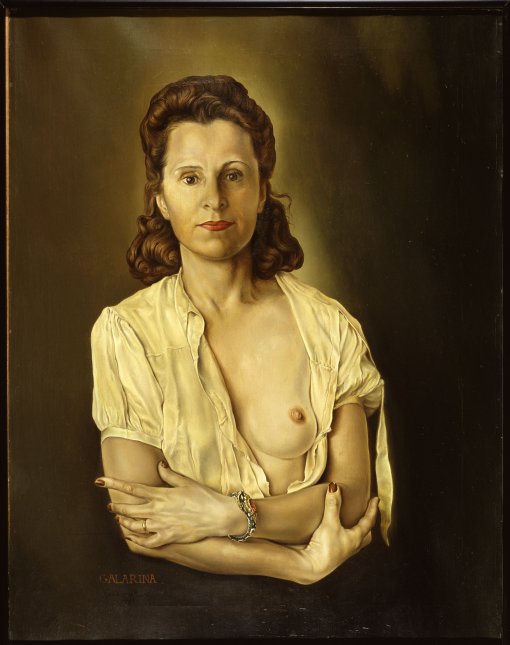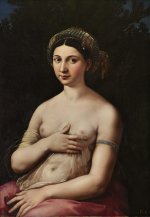Galarina

Artworks by Raphael

Rafael, La Fornarina, c. 1520. Gallerie Nazionali - Palazzo Barberini, Roma
Courtesy of the Gallerie Nazionali di Arte Antica- Bibliotheca Hertziana, Istituto Max Planck for the Histoy of Art/Enrico Fontolan
About the Artwork

- Title
- Galarina
- Author
- Salvador Dalí
- Cat. no.
- P 597
- Date
- 1945
- Technique
- Oil on canvas
- Dimensions
- 64 x 50 cm
Fiona Mata - Centre for Dalinian Studies
The first phase of the exhibition Dalí/Raphael, a prolonged revery, which explores the influence of Raphael Sanzio (1483-1520) on Salvador Dalí (1904-1989), was presented at the Dalí Theatre-Museum in Figueres on 26 November 2018. The idea for the exhibition came from the Prado Museum's bicentenary and the associated On Tour through Spain project [1], n which a painting from the Prado collection was placed on loan to a museum in each of Spain's autonomous communities. In the case of Catalonia, it was agreed that the Dalí Theatre-Museum would exhibit, for one month, Raphael's Madonna of the Rose, painted around 1517. This loan provided an opportunity to establish a dialogue with Dalí, who held the Renaissance masters in the greatest esteem and considered Raphael one of art's great geniuses. In the context of the nuclear-mystical language characteristic of Dalí's work of the 1940s and '50s characteristic of that period in Dalí's work, Raphael's influence is apparent in The Ascension of Saint Cecilia, c. 1955, in which Dalí reinterprets Raphael's Saint Catherine of Alexandria (c. 1507).[2]
When Raphael's Madonna of the Rose was returned to the Prado, the second phase of the exhibition began: Dalí's Saint Peter's Basilica, was displayed in its place, providing an invitation to explore Dalí's creative process. In this canvas, Dalí once again depicts Saint Cecilia / Saint Catherine, this time in the middle of Saint Peter's Basilica in the Vatican, for which he used as his model a neoclassical engraving attributed to Francesco Piranesi and Louis-Jean Desprez [3] showing the interior of the basilica.
Painted between 1959 and 1974, Saint Peter's Basilica documents a moment of transition in Dalí's art, as he gradually abandoned the nuclear-mystical idiom and began to experiment with artists such as Raphael, Michelangelo Buonarroti and Diego Velázquez, as well as with innovative visual effects, such as stereoscopic imaging or double-imagery.
The third and final phase of the exhibition will start with the celebration, in 2020, of the 500th anniversary of Raphael's death (he was born in Urbino and died in Rome) and will feature one of Dalí's signature works-one which has always been part of the artist's collection and which, on this occasion, will hang at the entrance to the exhibition Dalí/Raphael, a prolonged revery.
Galarina. Homage to Raphael
Dalí's first attempts, in the works produced in the early 1940s, to emulate the Renaissance and the classical world were tentative.[4] Mostly, he adapted the overall proportions and composition, that is to say, the deep structure, to create a sense of harmony that is difficult to appreciate at first glance. At the same time, his choice of iconography became more traditional, as he started to depict religious themes.[5]It is not until 1945, however, that we find works in which, departing from the norm, Dalí cites the classical heritage and in one case in particular-Galarina-pays clear homage to Raphael.
Dalí started on Galarina in 1944 and did not finish it until 1945, painting, by his own account, for three hours a day until it was completed.[6]The work on Galarina coincided with the convulsions of the last year and a half of World War II. As already mentioned, this was a time of change in Dalí's visual language.
Galarina is one of the best documented of Dalí's works, precisely because he valued it so highly. He wrote, for example, of how it pained him not to be able to finish the canvas during the war, especially after the United States bombed Hiroshima on 6 August 1945:
"The bomb at Hiroshima exploded in an immaculate sky. 'Pikadon' (Light and noise) was how the few surviving Japanese described it. I was painting Gala in a nude rear view [7] and Galarina, engrossed in my love and the charm of sensual fulfilment, when I felt the seismic shock of the explosion that filled me with terror. [...] The fact of being thus dependent to the hazards of history disquieted me. No one was safe in any corner of the world. I resolved to study without delay the best way to preserve my precious existence from the inroads of death and began seriously to be concerned with formulas for immortality."[8]
Dalí seems to have found salvation in the style and eternal beauty he perceived and so often extolled in Renaissance art. Raphael's La Fornarina is a clear example of that eternal beauty. As Cardinal Pietro Bembo wrote in the painter's epitaph:
"This is that Raphael, by whom in life our mighty Mother Nature feared defeat and in whose death did fear herself to die."[9]Raphael was born on 6 April 1483 in Urbino and died thirty-seven years later, on 6 April 1520, in Rome, where he was working for the Papal Court and apparently was hoping to be named cardinal, as Giorgio Vasari explains in his Le vite dei più eccellenti pittori, scultori e architettori (1550). In his biography, Vasari writes that Raphael was an amorous man and sometimes struggled to keep his mind on the job at hand until he had his current lover with him.[10] It is precisely that love, or idealisation, that led him to paint the portrait of Margherita Luti, the daughter of a baker (in Italian, fornaio) from Trastevere.[11]
When Raphael painted La Fornarina, towards the end of his life, he depicted the model in an unusual way compared to his other works.[12] Semi-nude, in the pose of Venus or Aphrodite Pudica,[13] but seated, the young woman looks at the spectator. With her left hand she lightly covers her groin, while with her right she makes a gesture as if to cover her breast. Her jet-black hair is wrapped in a gold and blue Oriental turban, from which hangs a pearl, in contrast to her dark hair. Her skin is white and pale, but the pink of her cheeks give her face the vivacity typical of Raphael. Her face is quite unlike the faces of the women Raphael usually represented in his paintings: while the others are remarkable for closely coinciding with an ideal model of beauty (the beauty which the Renaissance artists derived from the study and contemplation of Greco-Roman ideals), the face of La Fornarina is natural and displays imperfections, without losing the Italian artist's characteristic sweetness, serenity and harmony. The Fornarina is adorned with a shining gold and sapphire-blue armband, on which the painter has signed "RAPHAEL URBINAS", in what has been interpreted as a token of the love he has promised her-a promise reinforced by the leafy background of myrtle and quince, symbolising love and fertility.[14]
It is not surprising that Dalí should have been fascinated by Raphael, who was not only a painter but also an architect, that is to say, an artist who worked in different disciplines and who was recognised by both the Church and academic art circles-in a word, one of the pillars of the Renaissance.[15] The classical manner of Galarina is thus understandable, although it is completely unlike the other works of that period, which are oriented more towards nuclear physics. Galarina stands apart in its sobriety, harmony and balance, all qualities characteristic of Raphael. We see Gala depicted in front of a neutral background, with her typical hairstyle, recalling the fashion of the 1940s. Her white blouse leaves her right breast exposed, just like La Fornarina, and she wears very light make-up with red lipstick. Her arms are folded and on her wrist is a green bracelet with a red gemstone. The bracelet appears to represent an ouroboros, [16] the emblematic snake eating its own tail from Egyptian and Greek culture, a symbol that has already appeared once before in a Dalí painting: the same bracelet can be seen in Original sin. The varnish on Gala's nails, which are a darker red than her lips, is starting to chip. In the inscription on the canvas, Dalí has imitated the handwriting with which Raphael signed his work.
Dalí presented Galarina in 1945 at the Recent Paintings by Salvador Dalí exhibition at the Bignou Gallery in New York.[17] After the presentation, he kept it in his private collection until eventually he decided to put it on show in the Treasure Room at the Dalí Theatre-Museum, where he gathered his most important works.[18]
During the 1940s, the reactions of the press and art critics, who initially had celebrated the painter's Surrealist works, became more critical, their complaint being that he kept repeating himself. With Galarina, Dalí broke the pattern and displayed his skill and mastery of drawing and painting. The exhibition and especially the portrait of Gala were soon acclaimed in the press:
"The cunning of his brush has in no way grown tarnished. On the technical side he can be as trompe-l'oeil as Harnett, as sensuously poetic as Botticelli, depending upon the mood. The Basket of Bread and the Galarina are gems of minute observation."[19]
Dalí's reading and reinterpretation of La Fornarina reveal a solid knowledge not only of Renaissance art but also-like the quattrocento and cinquecento humanists-of the Greco-Roman past, from which he took the elements he needed in order to paint in his own way:
"Some of the unadulterated variety of surrealism, with vast space and already academically Freudian symbols, appears among the paintings and drawings which make up Dali's current one man show at Bignou Gallery. But two other trends are also apparent, adding much to the interest of this as always fashionable event. With long and intricate titles, which are so much a part of an art closely tied to literary concepts - Napoleon's Nose, Transformed into a Pregnant Woman, Strolling His Shadow with Melancholia amongst Original Ruins ,for example - there are meticulously painted and complicated allegories of the style by which Dali is best known. (...) Super-realist in its ultimate sense are the canvases The Basket of Bread and Galarina, being almost super-academic. as tactile values, and are very beautiful. But in two paintings, The Broken Bridge and The Flight, the Temptation, The Love, The Broken Wings , there is a new poetry, as lyric and seductive as Piero di Cosimo, as tender in mysterious green and blue tones as Fragonard, as rhythmic as Botticelli."[20]
The parallels between Dalí and Raphael are evident and show that Dalí studied Raphael's work very deeply,[21] as is also apparent from his personal library, which contains numerous volumes in Spanish, English and French on the history of art in general and of the Renaissance and its masters in particular. Indeed, from some of these books we can trace how Dalí studied and approached Raphael [22] and begin to understand how he delved into the subject and adopted key elements: the liveliness he gave to his portrait of Gala is unique and seems intended to capture the "Visage perceur de murailles",[23]or wall-piercing gaze, which Gala's former husband, the poet Paul Éluard, so admired. Gala was Dalí's muse and lover, just as Margherita Luti was Raphael's. Galarina is thus a tribute to Raphael and at the same time a declaration of love to Gala:
"... because Gala is to me what his Fornarina was to Raphael."[24]
-
On Tour through Spain, Museo Nacional del Prado, Madrid, 2018-2019, (accessed 04/10/2019).
-
Work held by London's National Gallery (accessed 04/10/2019).
-
Attributed to Louis-Jean Desprez (1743-1804), Interior of St. Peter's Illuminated; 16th century, Italy; 2009-4-3, (accessed 17/10/2019). See also: Montse Aguer, "Explosion of Mystical Faith in the Midst of a Cathedral", in Monographic Dalí/Raphael, 2018 (accessed 18/10/2019).
-
Three of the main sources to learn more about Dalí's admiration for the Renaissance and its influence on his art are Carme Ruiz, "Reflections of Classicism", in Dalí Atómico, Fundación Bancaria "la Caixa", Barcelona, 2018, pp. 54-67; Dalí. Il sogno del Classico, Skira, Milan, 2016; and Lucia Moni, "Dalí: To Become Classic! Now or Never", in Monographic Dalí/Raphael, 2018, (accessed 03/10/2019).
-
The paintings that exemplify this new direction are: Family of marsupial centaurs, 1940 (P494), Poetry of America, 1943 (P577) and The Madonna, 1943 (P574).
-
Recent Paintings by Salvador Dalí, an exhibition held at the Bignou Gallery in New York, 20 November to 29 December, 1945. Centre for Dalinian Studies, Fundació Gala-Salvador Dalí, Figueres.
-
The artist is no doubt referring to My Wife, Nude, Contemplating her own flesh becoming Stairs, Three Vertebrae of a Column, Sky and Architecture (P598).
-
Salvador Dalí, André Parinaud, The Unspeakable Confessions of Salvador Dalí, William Morrow and Company, New York, 1976, p. 202.
-
Raphael is buried in the Pantheon of Agrippa in Rome. Giorgio Vasari, Las vidas de los más excelentes arquitectos, pintores y escultores italianos desde Cimabue hasta nuestros tiempos, Ediciones Cátedra, Madrid, 2002, p. 520.
-
Here, Giorgio Vasari is referring to the commission Raphael received from Agostino Chigi, a Sienese merchant, to decorate the loggia of the Villa Farnesina between 1515 and 1517. See Giorgio Vasari, op. cit., p. 539.
-
La Fornarina, Palazzo Barberini, Rome,(accessed 17/10/2019).
-
Other works worth citing include the Madonna of the Rose, Saint Catherine of Alexandria, The Sistine Madonna, The Ansidei Madonna and Madonna of the Goldfinch.
-
This is a Hellenistic type, characterised by the fact of covering the breast with one hand and the groin with the other. See "Venus púdica", Museo Nacional del Prado, Madrid. (accessed 17/10/2019).
-
La Fornarina, Palazzo Barberini, op. cit.
-
E. H. Gombrich, Historia del arte, Alianza, Madrid, 1987, pp. 259-266.
-
According to Egyptian and Greek mythology, the ouroboros symbolises the unity of all things, both material and spiritual, which never disappear but change and are transformed in an eternal cycle of destruction and creation.
-
Recent Paintings by Salvador Dalí, op. cit.
-
Antoni Pitxot, Montse Aguer, Theatre-Museum Dalí. Figueres, Fundació Gala-Salvador Dalí, Triangle Postals, Figueres, Menorca, 2016, p. 71.
-
Edward Alden Jewell, "Cosy Surrealism", New York Times, New York, 25/11/1945.
-
"Dali: New and Old Surrealism", Art News, New York, 1-14 November 1945.
-
See Andrea Bonet, Anna Garcia, Anna Massot, "Dalí & Raphael in the Catalogue Raisonné", in Monographic Dalí/Raphael, at (accessed 18/10/2019).
-
As shown in the book Raphael, Hyperion, New York, 1941. Centre for Dalinian Studies, Fundació Gala-Salvador Dalí, Figueres.
-
Paul Éluard, Max Ernst, Au défaut du silence, Bibliothèque des Introuvables, Paris, 2005, p. 11.
-
Recent Paintings by Salvador Dalí, op. cit.

